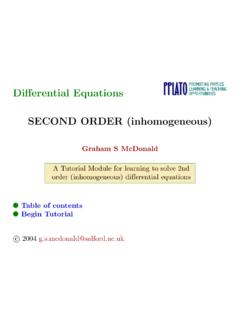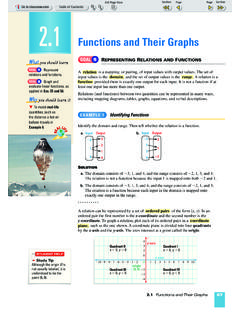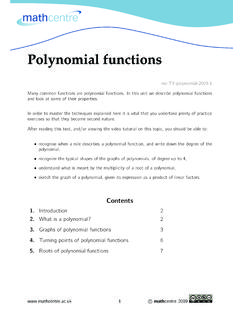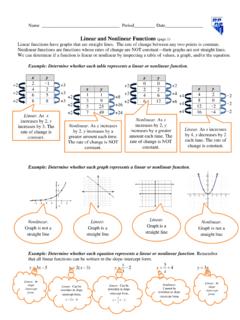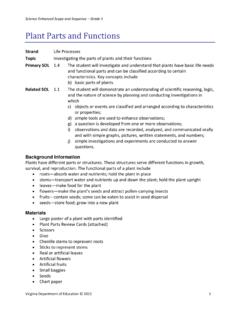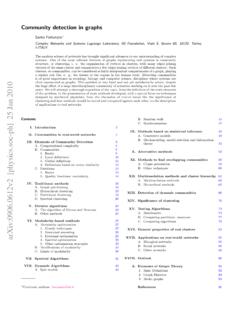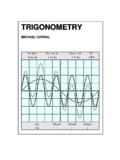Transcription of Quadratic Functions and Their Graphs - Salford
1 Basic MathematicsQuadratic Functions and TheirGraphsR Horan & M LavelleThe aim of this document is to provide a short,self assessment programme for students who wishto acquire a basic competence at sketching graphsof Quadratic , Revision Date: December 2, 2003 Version of Functions (Introduction) ofy=ax2+ ofy=a(x k) ofy=a(x k)2+ of a General on Quadratic GraphsSolutions to ExercisesSolutions to QuizzesSection 1: Quadratic Functions (Introduction)31. Quadratic Functions (Introduction)A general Quadratic function has the formy=ax2+bx+c,wherea,b,care constants anda6= simplest of these isy=x2whena= 1andb=c= following observations can be madeabout this simplest example. Since squaring any number gives a positive number, the valuesofyare all positive, except whenx= 0, in which casey= 0.
2 Asxincreases in size, so doesx2,but the increase in the valueofx2is faster than the increase inx. The graph ofy=x2is symmetric about they-axis (x= 0).For example, ifx= 3the correspondingyvalue is32= 3,then theyvalue is( 3)2= twoxvalues areequidistant from they-axis, one to the left and one to the right,but the twoyvalues are the same height above 1: Quadratic Functions (Introduction)4 This is sufficient to sketch the axisaxis of symmetryDiagram 1 Sketch ofy= 1: Quadratic Functions (Introduction)5 Referring todiagram 1, the graph ofy=x2, the linex= 0( they-axis) will be calledthe line of symmetryfor this Quadratic . the liney= 0( thex-axis) will be calledthe orthogonal axisfor this the equation is, say,y= 2x2then the graph will look similar tothat ofy=x2but will lie above it.
3 For example, whenx= 1thevalue ofx2is1, but the value of2x2is2. Theyvalue fory= 2x2is above that fory=x2. Similarly, for the equationy=x2/2, thegraph looks similar to that ofy=x2but now lies below is illustrated in the diagram on the next 1: Quadratic Functions (Introduction)6 Oyxa= 1a>10<a<1orthogonal axisaxis of symmetryDiagram 2 Sketch ofy=ax2fordifferentpositivevalues ofaSection 1: Quadratic Functions (Introduction)7 Consider now the choicea= 1,with the equationy= case the graph of the equation will have the same shape butnow, instead of beingabovethex-axis it isbelow. Whenx= 1thecorrespondingyvalue is 1. Examples ofy=ax2for variousnegativevalues ofaare sketched axisaxis of symmetryOyxa= 1a< 1 1<a<0 Diagram 3 Sketch ofy=ax2, fordifferentnegativevalues 1: Quadratic Functions (Introduction)8 QuizThe diagram below shows a sketch of three the appropriate option from the following.
4 (a)a>bandc>0,(b)b>canda>0,(c)c>b>a,(d)b> c> 2: graph ofy=ax2+c92. graph ofy=ax2+cThis type of Quadratic is similar to the basic ones of the previouspages but with a constant added, having the general formy=ax2+ a simple example of this take the casey=x2+ 2. Comparingthis with the functiony=x2, the only difference is the addition of2units. Whenx= 1,x2= 1,butx2+ 2 = 1 + 2 = 3. Whenx= 2,x2= 4,butx2+ 2 = 4 + 2 = 6. Theseyvalues have beenliftedby2units. This happens forallof thexvalues so theshapeof the graph isunchanged but it is lifted , the graph ofy=x2 2will 2: graph ofy=ax2+c10 Oaxis of symmetryyxy=x2+ 22y=x2y=x2 2-2 Diagram 4 Sketch ofy=x2+c,forc= 2,0, 3: graph ofy=a(x k)2113. graph ofy=a(x k)2In the examples considered so far, theaxis of symmetryis they-axis, the linex= next possibility is a Quadratic which has itsaxis of symmetrynot onthey-axis.
5 An example of this isy= (x 3)2,which has the same shape and the same orthogonal axis asy=x2but whose axis of symmetry is the linex= 3. The pointsx= 0andx= 6are equidistant from3. Whenx= 0theyvalue is(0 3)2= 9. Whenx= 6theyvalue is(6 3)2= 9. The points on the curve at these values are both9units abovethex-axis. This is true forallnumbers which are equidistant graph ofy= (x 3)2is illustrated on the next 3: graph ofy=a(x k)212orthogonal axis9axis of 5 Sketch ofy= (x 3)2.(Not to scale)Section 4: graph ofy=a(x k)2+m134. graph ofy=a(x k)2+mSo far two separate cases have been discussed; first a standard quadratichas itsorthogonal axisshifted up or down, second a standard quadratichas itsaxis of symmetryshifted left or right. The next step is to con-sider quadratics that incorporate both 1 The quadraticy=x2is shifted so that itsaxis of sym-metryis atx= 3and itsorthogonal axisis aty= 2.
6 (a)Write down the equation of the new curve.(b)Find the coordinates of the point where it crosses theyaxis.(c)Sketch the (a)The new curve is symmetric aboutx= 3and is shifted up by2units so its equation isy= (x 3)2+ 2.(b)The curve crosses theyaxis whenx= 0. Putting this into theequationy= (x 3)2+ 2, the corresponding value ofyisy= (0 3)2+ 2 = 11, so the curve crosses theyaxis aty= 4: graph ofy=a(x k)2+m14(c)The curve is sketched axis11axis of 5 Sketch ofy= (x 3)2+ 2.(Not to scale)Section 4: graph ofy=a(x k)2+m15 Exercise curvey= 2x2is shifted so that its axis of sym-metry is the linex= 2and its orthogonal axis isy= 8. (Click onthegreenletters for solution.)(a)Write down the equation of the new curve.(b)Find the coordinates of the points where this new curve cutsthexandyaxes.
7 (c)Sketch the the above for each of the following. (Click onthegreenletters for solution.)(a)The curvey=x2is shifted so that its axis of symmetry is thelinex= 7and its orthogonal axis isy= 6.(b)The curvey=x2is shifted so that its axis of symmetry is thelinex= 7and its orthogonal axis isy= 9.(c)The curvey= x2is shifted so that its axis of symmetry is thelinex= 7and its orthogonal axis isy= 5: graph of a General Quadratic165. graph of a General QuadraticThe final section is about sketching general Quadratic Functions , of the formy=ax2+bx+ algebraic expression must be rearranged so that theline of sym-metryand theorthogonal axismay be determined. The procedurerequired iscompleting the square.(See the package onquadratics.)Example 2A Quadratic function is given asy= 2x2+ 4x+ 16.
8 (a)Complete the square on this function.(b)Use this to determine the axis of symmetry and the orthogonalaxis of the curve.(c)Find the points on thexandyaxes where the curve crosses them.(d)Sketch the 5: graph of a General Quadratic17 Solution(a)Completing the square:y= 2x2+ 4x+ 16= 2(x2 2x) + 16= 2[(x 1)2 1]+ 2(x 1)2+ 18(b)This is the functiony= 2x2moved so that its axis of symmetryisx= 1and its orthogonal axis isy= 18.(c)The function isy= 2(x 1)2+ 18. This will cross thex-axiswheny= 0, when 2(x 1)2+ 18=018=2(x 1)29=(x 1)2taking square rootsx 1= 3x=1 3=4,or 0into the original form of the function at the topof this page, givesy= 16, it crosses theyaxis aty= 5: graph of a General Quadratic18(d)The function is sketched axisaxis of ofy= 2x2+ 4x+ 16.
9 (Not to scale)Section 5: graph of a General Quadratic19 Here are some exercises for the method ofexample 2to sketch each of the fol-lowing Quadratic Functions . (Click on thegreenletters for solution.)(a)y=x2+ 2x+ 1(b)y= 6 x2(c)y=x2 6x+ 5(d)4x x2(e)y=x2+ 2x+ 5(f)3 2x x2 This section ends with a short of the following pairs of lines is theaxis of symmetryandorthogonal axisrespectively of the Quadratic functiony= 2x2 8x?(a)x= 2,y= 8,(b)x= 2,y= 8,(c)x= 2,y= 8,(d)x= 2,y= 6: Quiz on Quadratic Graphs206. Quiz on Quadratic GraphsBegin QuizEach of the following questions relates to the quadraticfunctiony= x2+ 6x+ which of the following two points does it cross thexaxis?(a)x= 1,7(b)x= 1, 7(c)x= 1,7(d)x= 1, which of the following does it cross theyaxis?
10 (a)y= 7(b)y= 8(c)y= 5(d)y= of the following is theaxis of symmetry?(a)x= 2(b)x= 2(c)x= 3(d)x= of the following is theorthogonal axis?(a)y= 14(b)y= 15(c)y= 16(d)y= 13 End QuizSolutions to Exercises21 Solutions to ExercisesExercise 1(a)The equation isy= 2(x+ 2)2+ on the green square to return Solutions to Exercises22 Exercise 1(b)The curve cuts theyaxis whenx= 0. Puttingx= 0into the equationy= 2(x+ 2)2+ 8, the correspondingyvalue is 2(0 + 2)2+ 8 = 2(2)2+ 8 = 8 + 8 = 0, curve cuts thexaxis wheny= 0. In this case putting the valuey= 0into the equationy= 2(x+ 2)2+ 8leads to 2(x+ 2)2+ 8=08=2(x+ 2)2(x+ 2)2=4x+ 2= 2x= 2 2so there are two solutions,x= 4andx= summarise the graph cuts the coordinate axes at the two pointswith coordinates( 4,0)and(0,0).




